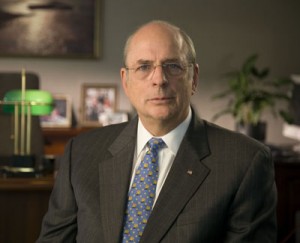NASA needs direction? Call Norm Augustine!
Norman Augustine, that perennial blue-ribbon panelist, just accepted the easiest gig of his career—or the hardest

Norman Augustine, that perennial blue-ribbon panelist, just accepted the easiest gig of his career—or the hardest. He's been asked by the White House to review NASA's plans for human space exploration, to help chart a "vigorous and sustainable" path forward. If Augustine wanted, he could just dust off the report from another panel he chaired in 1990, slap on a new cover, and be finished by Monday—because the findings and "concerns" identified by the Advisory Committee on the Future of the U.S. Space Program are as relevant today as they were two decades ago.
The 1990 panel worried about a "lack of a national consensus as to what should be the goals of the civil space program." Still true. They said "NASA is currently overcommitted in terms of program obligations relative to resources available." It still is—and the Obama administration just (tentatively, pending the results of Augustine's review) cut another $3.5 billion from NASA's exploration budget for the next four years. The 1990 report lamented management inefficiencies at the space agency, a graying workforce, and the tendency "for projects to grow in scope, complexity, and cost." Check, check, and check.
Augustine tried to warn of the problems 19 years ago, but was mostly ignored. So where does that leave us? And what can the chairman say that he didn't say then? That's where his job becomes difficult.
He could start by accepting that the money situation won't improve, no matter who takes the reins at NASA. The last two administrators, Sean O'Keefe and Mike Griffin, could hardly have been more different, style-wise. O'Keefe was a smooth Washington insider, the kind who answered nasty attacks at congressional hearings with a smile and a "Thank you, Senator, for the question." Griffin was no charmer, hard-headed to the point of arrogance and unable to conceal his contempt for non-engineers. Both men were very well connected. O'Keefe had strong personal ties to Dick Cheney, the most powerful Vice President in U.S. history. Griffin had the backing of Barbara Mikulski, who has more influence over NASA's budget than any other member of Congress.
When it came to getting more money, though, none of this mattered a bit. As Griffin pointed out recently, the budget for the Moon-Mars program has been cut by more than $15 billion in the five years since it came into existence. We've now reached the point, he claims, where "this work cannot be done" at current funding levels.
So if the money's not forthcoming, what then? Go slower? Augustine recommended in 1990 a "go as you pay" approach. Basically, NASA should send people beyond Earth orbit as expeditiously as its budget allows. But that has the downside of driving up the final cost. Expensive aerospace engineers have to be paid every week, regardless of how long you stretch out the schedule. And it's hard to sustain public interest when there's no visible sign of progress. Only now, five years after the Bush administration declared its "vision" for space exploration, are we seeing the first significant hardware tests in the Constellation program.
One solution—which admittedly, seems like a pipe dream today—would be for the U.S. aerospace industry to somehow become more efficient, and find a way to do a safe, exciting, and realistic human spaceflight program with the $22 billion NASA's been told it can spend on exploration between now and 2013. To some people, that's a lot of money. And there's no shortage of ideas and talent among aerospace engineers. In 1990, Augustine's panel wrote that "the nation must turn to new and revolutionary technologies to build more capable and significantly less costly means to launch manned and unmanned spacecraft." If, in 2009, he can suggest how, exactly, we might accomplish that, he will truly earn his blue ribbon.